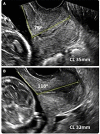A novel aspiration technique to assess cervical remodelling in patients with or without cervical shortening: Sequence of first changes, definition of cut-off values and impact of cervical pessary, stratified for cervical length
- PMID: 37023066
- PMCID: PMC10079006
- DOI: 10.1371/journal.pone.0283944
A novel aspiration technique to assess cervical remodelling in patients with or without cervical shortening: Sequence of first changes, definition of cut-off values and impact of cervical pessary, stratified for cervical length
Abstract
Background: The therapeutic significance of the cervical pessary has been confirmed by several studies. However, the underlying mechanism by which pessaries reduce the risk of a preterm birth remains elusive. The aim of this study is to investigate the hypothesis whether the application of a cervical pessary may stabilize the ectocervical stiffness in order to achieve a cervical arrest.
Methods: This is a prospective, controlled, non-interventional, post-market, monocentric, longitudinal, cohort study in a tertiary maternity hospital to determine ectocervical stiffness and its changes measured before and after placement of a pessary in singleton pregnancies with cervical shortening in the mid trimester. In order to assess reference values for cervical stiffness, we measured also singleton pregnancies with normal cervical length in the same gestational week spectrum. The cervical stiffness measured with the Pregnolia System as the Cervical Stiffness Index (CSI, in mbar) shall be the primary endpoint, whilst patient delivery data (gestational age, mode of delivery and complications) will be the secondary endpoint. In this pilot study, up to 142 subjects will be enrolled to have a total of 120 subjects (estimated dropout rate of 15%) to complete the study; pessary cohort: 60 (up to 71 recruited), control group: 60 (up to 71 recruited).
Discussion: Our hypothesis is that patients with cervical shortening will present with lower CSI values and that pessary placement will be able to stabilize the CSI values through further prevention of cervical remodelling. The measurement of controls with normal cervical length shall serve as a reference.
Copyright: © 2023 Kyvernitakis et al. This is an open access article distributed under the terms of the Creative Commons Attribution License, which permits unrestricted use, distribution, and reproduction in any medium, provided the original author and source are credited.
Conflict of interest statement
Sabrina Badir is the founder of Pregnolia AG, the manufacturer of the Pregnolia System. Pregnolia AG provides the devices for this study and a grant to support the study (IK). This does not alter our adherence to PLOS ONE policies on sharing data and materials. The other authors have no conflict of interest to report.
Figures




Similar articles
-
Effectiveness of cervical pessary in women with arrested preterm labor compared to those with asymptomatic cervical shortening.J Matern Fetal Neonatal Med. 2022 Dec;35(25):8141-8146. doi: 10.1080/14767058.2021.1962844. Epub 2021 Dec 2. J Matern Fetal Neonatal Med. 2022. PMID: 34856856
-
Cervical modifications after pessary placement in singleton pregnancies with maternal short cervical length: 2D and 3D ultrasound evaluation.Acta Obstet Gynecol Scand. 2019 Nov;98(11):1442-1449. doi: 10.1111/aogs.13647. Epub 2019 Jun 13. Acta Obstet Gynecol Scand. 2019. PMID: 31102541
-
Arabin pessary to prevent adverse perinatal outcomes in twin pregnancies with a short cervix: a multicenter randomized controlled trial (PESSARONE).Am J Obstet Gynecol. 2022 Aug;227(2):271.e1-271.e13. doi: 10.1016/j.ajog.2022.01.038. Epub 2022 Feb 3. Am J Obstet Gynecol. 2022. PMID: 35123930 Clinical Trial.
-
Effectiveness of the cervical pessary for the prevention of preterm birth in singleton pregnancies with a short cervix: a meta-analysis of randomized trials.Arch Gynecol Obstet. 2019 May;299(5):1215-1231. doi: 10.1007/s00404-019-05096-x. Epub 2019 Feb 19. Arch Gynecol Obstet. 2019. PMID: 30778728
-
[Use of pessaries to prevent preterm birth: Are we going back to mechanical devices in obstetrics?].J Gynecol Obstet Biol Reprod (Paris). 2015 Oct;44(8):776-80. doi: 10.1016/j.jgyn.2015.06.013. Epub 2015 Jun 29. J Gynecol Obstet Biol Reprod (Paris). 2015. PMID: 26139034 Review. French.
Cited by
-
The PRECISION study protocol: Can cervical stiffness in the second trimester predict preterm birth in high-risk singleton pregnancies? A feasibility, cohort study.PLoS One. 2025 Feb 21;20(2):e0316297. doi: 10.1371/journal.pone.0316297. eCollection 2025. PLoS One. 2025. PMID: 39982966 Free PMC article.
-
The CASPAR study protocol. Can cervical stiffness predict successful vaginal delivery after induction of labour? a feasibility, cohort study.PLoS One. 2025 Jan 16;20(1):e0311324. doi: 10.1371/journal.pone.0311324. eCollection 2025. PLoS One. 2025. PMID: 39820788 Free PMC article.
-
Administration of Antenatal Corticosteroids: Optimal Timing.Geburtshilfe Frauenheilkd. 2024 Jan 3;84(1):48-58. doi: 10.1055/a-2202-5363. eCollection 2024 Jan. Geburtshilfe Frauenheilkd. 2024. PMID: 38205043 Free PMC article.
-
The biomechanical evolution of the uterus and cervix and fetal growth in human pregnancy.NPJ Womens Health. 2024;2(1):33. doi: 10.1038/s44294-024-00038-8. Epub 2024 Oct 3. NPJ Womens Health. 2024. PMID: 40747270 Free PMC article.
References
-
- Liu L, Oza S, Hogan D, Perin J, Rudan I, Lawn JE, et al.. Global, regional, and national causes of child mortality in 2000–13, with projections to inform post-2015 priorities: an updated systematic analysis. Lancet. 2015;385(9966):430–40. Epub 2014/10/05. doi: 10.1016/S0140-6736(14)61698-6 . - DOI - PubMed
Publication types
MeSH terms
LinkOut - more resources
Full Text Sources

